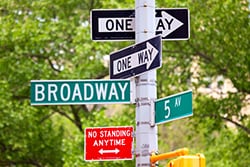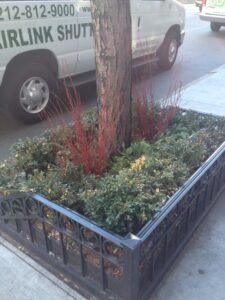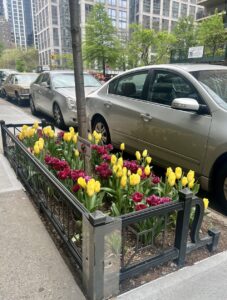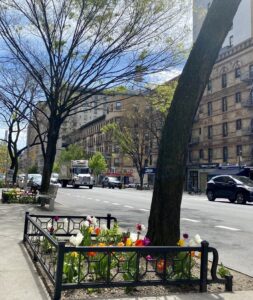Tree Guards – New York City
New York in recent years has made a few changes in the permitting and vocabulary surrounding their street trees. The New York City Department of Parks and Recreation which oversees the city’s street and park trees now refers to the little patch of soil surrounding the street trees “Tree Beds,” formally called “Tree Pits.” A welcome change in our eyes, as the word Tree Beds, similar to Garden Beds, congers up images of lush plantings and promise. Nobody is going to envision these beautiful thoughts when using the word “Pits.”
The new permitting process is all online. Gone are the days where you are manually hand writing and faxing in a permit. The Parks Department implemented a permitting process to ensure the health of street trees and safety of pedestrians, while at the same time being conscious of drivers ability to exit their vehicles. The online permit can be found at https://www.nycgovparks.org/trees/tree-care/tree-guards or for street tree information in general, visit Trees New York.

TREE GUARDS SHOULD
- Be recessed from the street, we recommend 18 inches;
- Be no shorter than 18 inches or no taller than 24 inches;
- Be made of metal;
- Allow water to freely enter the tree bed;
- Not have any sharp points;
- Not be anchored into the sidewalk; and
- Not be fastened with concrete in the tree bed.
These are all sensible criteria in our eyes and our guards meet all these criteria. For more information about tree guards in New York visit http://www.treeguards.nyc/



ENHANCING THE BEAUTY OF NEW YORK CITY WITH TREE GUARDS
New York City is renowned for its stunning skyline, bustling streets, and vibrant urban atmosphere. However, amidst the concrete jungle, the city is also home to a flourishing urban forest. Street trees bring life and beauty to the city’s neighborhoods, providing shade, improving air quality, and creating a sense of tranquility amid the hustle and bustle.
One significant way New York City is enhancing its urban landscape is through the implementation of modular metal tree guards like ours. These carefully designed metal structures encircle street trees, serving multiple purposes that contribute to the city’s overall beauty and charm.
First and foremost, tree guards offer protection. In a bustling metropolis like New York, street trees are vulnerable to accidental damage from vehicles, pedestrians, dogs, and other urban activities. Tree guards act as a physical barrier, safeguarding these valuable green assets from potential harm. By preventing direct contact and providing a safe zone around the tree, tree guards help preserve the health and longevity of street trees, ensuring they continue to grace the city for generations to come.
Moreover, our tree guards offer an opportunity for creative expression. These metal enclosures are made to be aesthetically pleasing and customizable, allowing for unique designs that reflect the character of the surrounding neighborhood. From intricate patterns to artistic motifs, tree guards can be adorned with elements that harmonize with the city’s architecture, adding a touch of elegance and visual interest to the streetscape.
Tree guards also create a sense of order and cohesion within the urban landscape. By defining the boundaries of the tree bed, they provide a clear distinction between the pedestrian pathway and the area designated for the tree’s growth. This delineation not only helps to guide foot traffic but also contributes to the overall organization and cleanliness of the city streets. Well-designed and properly maintained tree guards contribute to a sense of pride and care for the surrounding community, enhancing the overall beauty of New York City.
Furthermore, tree guards foster a connection between nature and the city environment. As pedestrians stroll along the sidewalks, the presence of tree guards draws attention to the majestic trees they protect. These visual cues serve as a reminder of the importance of urban greening and the role that nature plays in creating a livable cityscape. The juxtaposition of metal and foliage creates a captivating contrast, inviting passersby to pause, appreciate, and engage with the natural world amidst the urban setting.
Key Features of Curb Allure Tree Guards
Optimal Recess Distance: Curb Allure tree guards are constructed to be recessed from the street, providing a safe space for young trees to thrive. The recommended distance is at least 18 inches, although we advise going closer to 24 inches in commercial areas for enhanced protection.
Height Matters: The height of a tree guard plays a crucial role in shielding the tree’s delicate bark from harm. Curb Allure tree guards are designed to be no shorter than 18 inches and no taller than 24 inches, striking a perfect balance between protection and aesthetics.
Built to Last: These tree guards are crafted from durable metal, ensuring longevity and resilience in the face of urban wear and tear. They are robust enough to withstand encounters with weed trimmers and other potential hazards.
Water-Friendly Design: Recognizing the importance of moisture for tree health, Curb Allure tree guards are designed to allow water to freely enter the tree bed. This design feature ensures that newly planted trees receive the hydration they need to flourish.
Safety First: Curb Allure tree guards have smooth, rounded edges with no sharp points. This design minimizes the risk of injuries to pedestrians and also safeguards against unintended damage to the tree or the guards themselves.
Non-Invasive Installation: These tree guards are not anchored into the sidewalk, ensuring that they can be easily removed or adjusted as needed without causing damage to the urban infrastructure.
No Concrete Fastening: Curb Allure tree guards do not rely on concrete fastening in the tree bed, promoting a healthier environment for tree roots to grow and access essential nutrients.
Benefits to People and the City
Investing in Curb Allure tree guards goes beyond protecting trees; it benefits both residents and the city as a whole. Street trees improve air quality, reduce noise pollution, enhance property values, and contribute to a healthier and more aesthetically pleasing urban environment. By safeguarding newly planted trees with these innovative tree guards, New York City residents can enjoy these advantages to the fullest.
In the evolving landscape of New York City’s urban forestry, the transition from “Tree Pits” to “Tree Beds” symbolizes a commitment to nurturing the city’s greenery. Protecting newly planted trees, especially their tender bark, from mechanical damage is essential for their longevity and vitality. Curb Allure tree guards not only meet the city’s stringent criteria but also offer a practical and aesthetic solution for safeguarding these vital green assets. As the city continues to grow and evolve, these tree guards are a testament to New York’s dedication to creating a greener and more vibrant future.
We always try to keep our information as up to date as possible – but if we have missed something, please let us know (contact us at info@curballure.com), as we are happy to update this page as needed. The better informed we all are, the better it is for the street trees and your community.